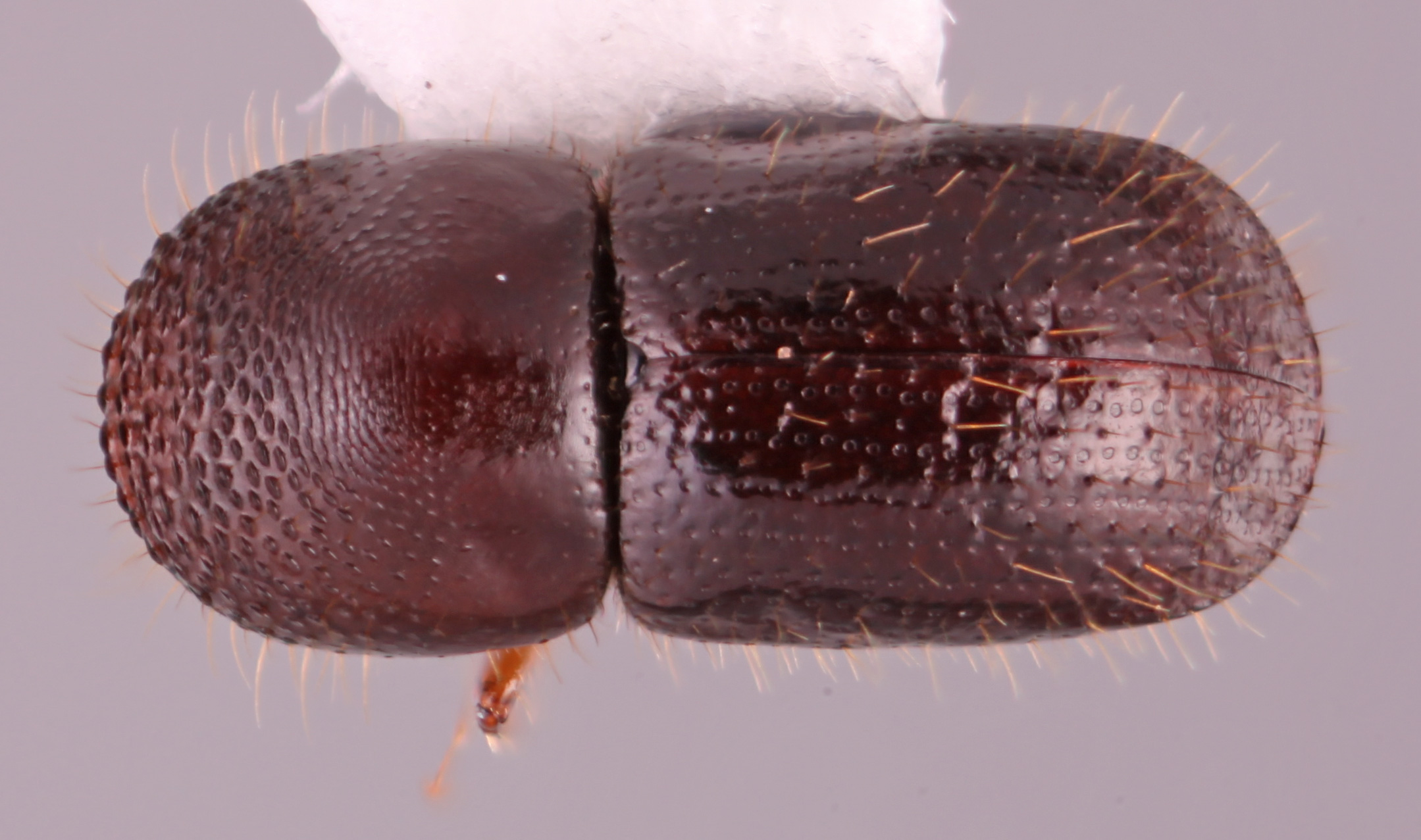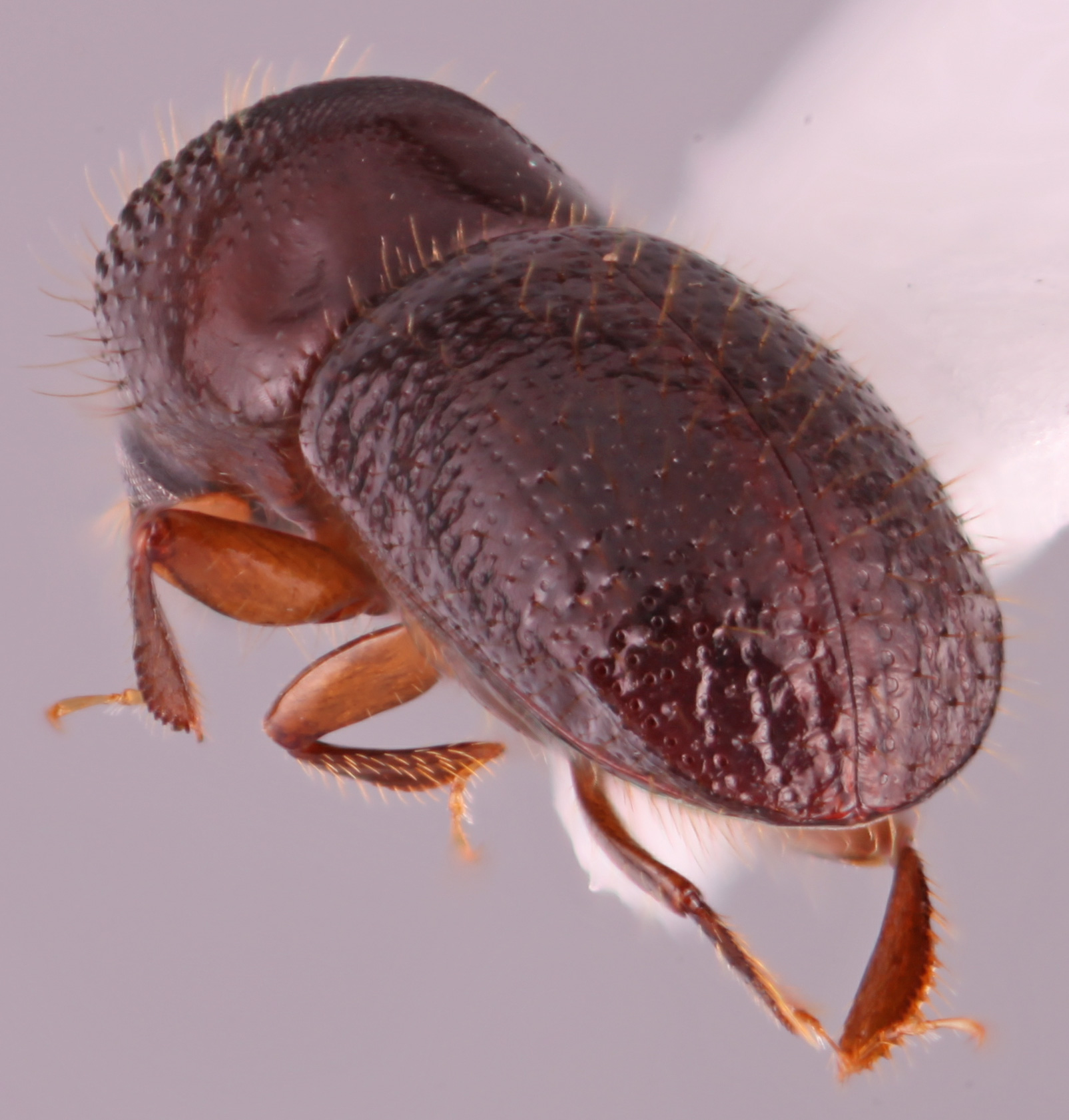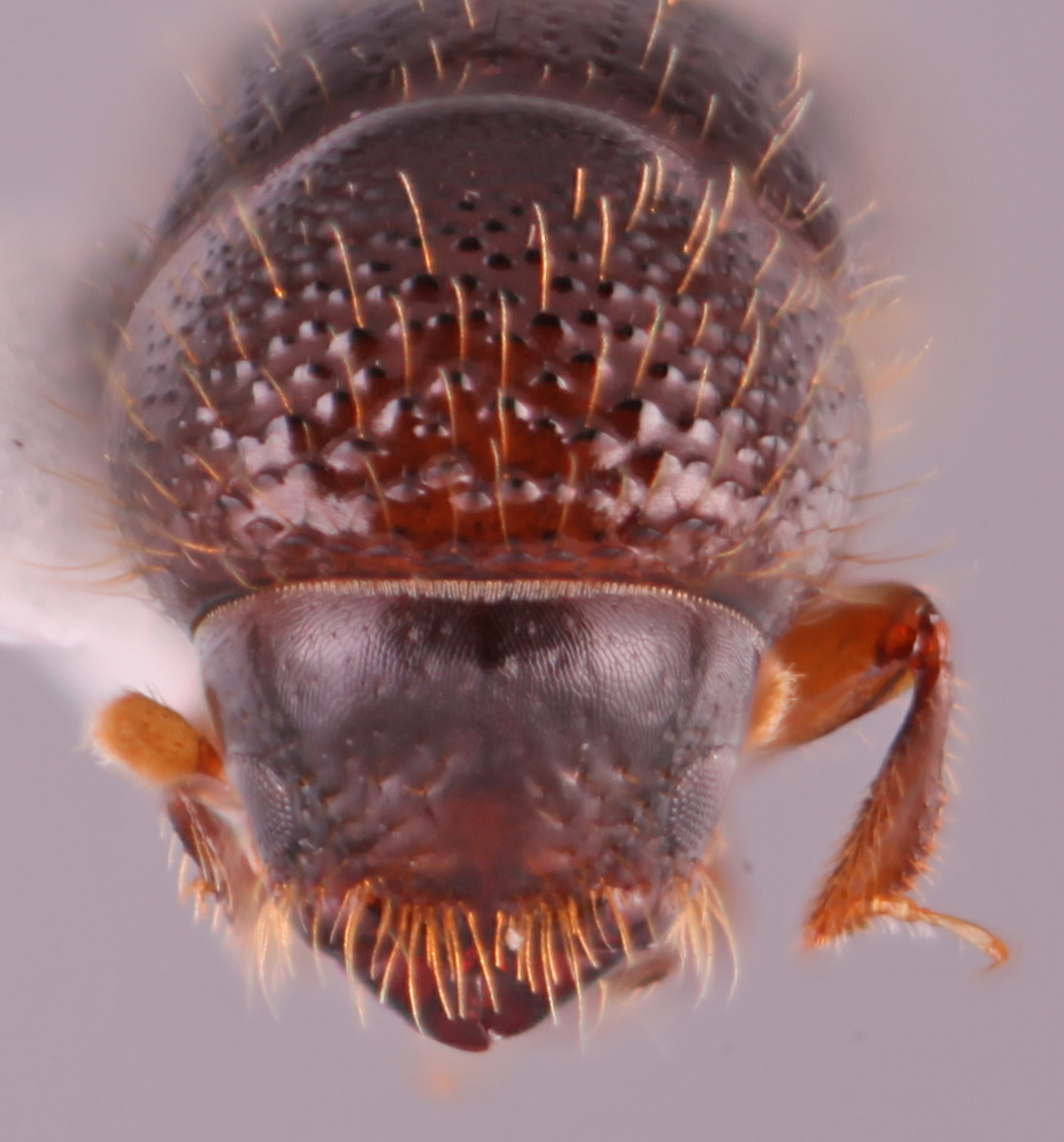Euwallacea perbrevis
|
Euwallacea perbrevis lateral; S.M. Smith |
|
Euwallacea perbrevis dorsal; S.M. Smith |
|
Euwallacea perbrevis declivity; S.M. Smith |
|
Euwallacea perbrevis frontal; S.M. Smith |
Taxonomic history
Xyleborus perbrevis Schedl, 1951a: 59.
Euwallacea perbrevis (Schedl): Wood, 1989: 173 (as a synonym of E. fornicatus).
Synonyms
Xyleborus molestulus Wood, 1975b: 400. Smith et al. 2020b: 248.
Diagnosis
2.3–2.5 mm long (mean = 2.44 mm; n = 5); 2.46–2.55 times as long as wide. This species is distinguished by the pronotumpronotum:
the dorsal surface of the thorax
basic (type 2) when viewed dorsally, anterioranterior:
the front or forward; opposite of posterior margin appearing rounded; elytralelytral:
margin appearing rounded; elytralelytral:
pertaining to the elytra
declivitydeclivity:
downward slope of either the pronotum or elytra
 rounded; declivitaldeclivital:
rounded; declivitaldeclivital:
pertaining to the elytral declivity
face convexconvex:
appearing rounded ; protibiaprotibia:
; protibiaprotibia:
tibia of the first pair of legs
outer margin rounded with 7–10 socketed denticlesdenticle:
a small tooth, the sides of which are equal and the tip is above the middle of the base , denticlesdenticle:
, denticlesdenticle:
a small tooth, the sides of which are equal and the tip is above the middle of the base small, their sockets small; declivitaldeclivital:
small, their sockets small; declivitaldeclivital:
pertaining to the elytral declivity
surface shiningshining:
appearing glossy or bright in luster; referring to a surface that is polished and reflects light well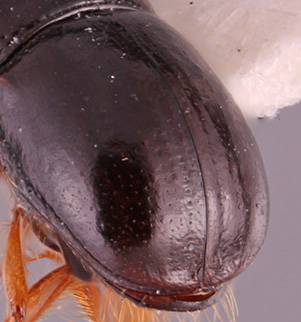 ; interstriaeinterstria:
; interstriaeinterstria:
longitudinal spaces along the elytra between the striae, which is not as<br />
impressed and bear smaller punctures.
 bearing sparse small granulesgranule:
bearing sparse small granulesgranule:
a small rounded protuberance, like grains of sand
 , posterolateralposterolateral:
, posterolateralposterolateral:
relating to end of the side part/portion
 margin of declivitydeclivity:
margin of declivitydeclivity:
downward slope of either the pronotum or elytra
 costate. This species is nearly identical to E. malloti and E. n. sp. 5 and can be separated by the elytralelytral:
costate. This species is nearly identical to E. malloti and E. n. sp. 5 and can be separated by the elytralelytral:
pertaining to the elytra
bases rounded and posterolateralposterolateral:
relating to end of the side part/portion
 declivitaldeclivital:
declivitaldeclivital:
pertaining to the elytral declivity
costacosta:
elevated ridge that is rounded at its crest, not necessarily with sharp appearance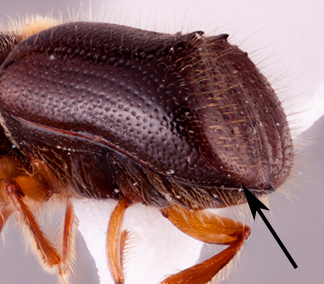 carinate and never granulategranulate:
carinate and never granulategranulate:
pertaining to a coarse, grainy surface texture
 .
.
This species is part of the Euwallacea fornicatus species complex, and the most reliable method to ensure accurate identification of these species is through generation of COI barcoding sequences (Gomez et al. 2018bGomez et al. 2018b:
Gomez DF, Skelton J, Steininger MS, Stouthamer R, Rugman-Jones P, Sittichaya W, Rabaglia RJ, Hulcr J. 2018b. Species within the Euwallacea fornicatus (Coleoptera: Curculionidae) complex revealed by morphometric and phylogenetic analyses. Insect Systematics and Diversity 2(6): 2, 1-11. https://doi.org/10.1093/isd/ixy018, Smith et al. 2019Smith et al. 2019:
Smith SM, Gomez DF, Beaver RA, Hulcr J, Cognato, AI. 2019. Reassessment of the species in the Euwallacea fornicatus (Coleoptera: Curculionidae: Scolytinae) complex after the rediscovery of the ldquo;lostrdquo; type specimen. Insects 10: 261. https://doi:10.3390/insects10090261). Gomez et al. (2018b; figure 1) provide morphological characters for separating the species based on measurements of elytralelytral:
pertaining to the elytra
length (lateral view; diagonally measured from the elytralelytral:
pertaining to the elytra
basebase:
point or edge closest to the body; opposite of apex to the apexapex:
to the apexapex:
point or edge furthest from the body; opposite of base
 ) and pronotalpronotal:
) and pronotalpronotal:
pertaining to the pronotum
length (lateral view; on a diagonal from pronotalpronotal:
pertaining to the pronotum
apexapex:
point or edge furthest from the body; opposite of base
 to pronotalpronotal:
to pronotalpronotal:
pertaining to the pronotum
basebase:
point or edge closest to the body; opposite of apex ). Species can be diagnosed using the combination of measurements given in Smith et al. 2019:
). Species can be diagnosed using the combination of measurements given in Smith et al. 2019:
| species | total length (dorsal) |
length/width ratio (dorsal) |
elytral elytral: pertaining to the elytra length (lateral; diagonal) |
pronotalpronotal: pertaining to the pronotum length (lateral; diagonal) |
elytral elytral: pertaining to the elytra width (dorsal) |
pronotal pronotal: pertaining to the pronotum width (dorsal) |
protibial denticles |
| E. fornicatior | 2.20–2.37 | 2.15−2.35 | 1.40–1.46 | 1.02–1.06 | 0.48–0.52 | 1.00–1.06 | 6−7 |
| E. fornicatus | 2.60−2.70 | 2.25−2.36 | 1.44–1.72 | 1.02–1.16 | 0.48–0.62 | 1.00–1.14 | 8–9 |
| E. kuroshio | 2.40−2.80 | 2.17−2.40 | 1.50–1.82 | 1.08–1.16 | 0.52–0.56 | 1.06–1.16 | 8−11 |
| E. perbrevis | 2.30−2.50 | 2.46−2.55 | 1.42–1.68 | 1.04–1.16 | 0.48–0.56 | 1.02–1.14 | 7−10 |
May be confused with
This species is part of the Euwallacea fornicatus species complex along with E. fornicatior, E. fornicatus, E. kuroshio from which it is difficult to distinguish. The species is also similar to Coptodryas inornata, E. andamanensis, E. geminus, E. malloti, E. neptis, E. semirudis, E. testudinatus, E. velatus, and Xylosandrus formosae.
Distribution
This species is confirmed from American Samoa, Australia, Brunei, China (Hainan), Fiji, Indonesia (Java), Japan (Okinawa), Malaysia (Java, Sabah), Palau, Papua New Guinea, Philippines, Réunion, Singapore, Sri Lanka, Taiwan, Thailand, Timor Leste, Vietnam, and introduced in the United States (Florida and Hawaii) (Gomez et al. 2018aGomez et al. 2018a:
Gomez DF, Rabaglia RJ, Fairbanks KEO, Hulcr J. 2018a. North American Xyleborini north of Mexico: a review and key to genera and species (Coleoptera, Curculionidae, Scolytinae). ZooKeys 768: 19-68. https://doi.org/10.3897/zookeys.768.24697), Costacosta:
elevated ridge that is rounded at its crest, not necessarily with sharp appearance Rica, and Panama (Kirkendall and Ødegaard 2007, reported as E. fornicatus) (Smith et al. 2019Smith et al. 2019:
Rica, and Panama (Kirkendall and Ødegaard 2007, reported as E. fornicatus) (Smith et al. 2019Smith et al. 2019:
Smith SM, Gomez DF, Beaver RA, Hulcr J, Cognato, AI. 2019. Reassessment of the species in the Euwallacea fornicatus (Coleoptera: Curculionidae: Scolytinae) complex after the rediscovery of the ldquo;lostrdquo; type specimen. Insects 10: 261. https://doi:10.3390/insects10090261).
Host plants
The species is known from Avicennia (Acanthaceae), Mangifera (Anacardiaceae), Cyathocalyx, Xylopia (Annonaceae), Bursera (Burseraceae), Terminalia (Combretaceae), Aleurites (Euphorbiaceae), Acacia, Erythrina (Fabaceae), Theobroma and Trichospermum (Malvaceae), Artocarpus (Moraceae), Myristica (Myristicaceae), Citrus (Rutaceae), Casearia (Salicaceae), and Litchi (Sapindaceae) (Smith et al. in review). It has been recorded from the following hosts under different names: Protium (Burseraceae), Cedrela (Meliaceae), Brosimum (Moraceae) (Kirkendall and Ødegaard 2007 as E. fornicatus), Camellia sinensis (Theaceae) (O'Donnell et al. 2015 as Euwallacea sp. #4), Annona (Annonaceae), Bursera (Burseraceae), Albizia, Lysiloma (Fabaceae) (Owens et al. 2018 as Euwallacea nr. fornicatus) (Smith et al. 2019Smith et al. 2019:
Smith SM, Gomez DF, Beaver RA, Hulcr J, Cognato, AI. 2019. Reassessment of the species in the Euwallacea fornicatus (Coleoptera: Curculionidae: Scolytinae) complex after the rediscovery of the ldquo;lostrdquo; type specimen. Insects 10: 261. https://doi:10.3390/insects10090261).
Remarks
Euwallacea perbrevis is commonly known as the tea shot hole borer (TSHB) which was previously thought to be a synonym of E. fornicatus (Smith et al. 2019Smith et al. 2019:
Smith SM, Gomez DF, Beaver RA, Hulcr J, Cognato, AI. 2019. Reassessment of the species in the Euwallacea fornicatus (Coleoptera: Curculionidae: Scolytinae) complex after the rediscovery of the ldquo;lostrdquo; type specimen. Insects 10: 261. https://doi:10.3390/insects10090261).
Various aspects of the biology of the species are described by Kalshoven (1958), Browne (1961b), Sivapalan (1975, 1977), Walgama (2012), Cooperband et al. (2016) and others as E. fornicatus. The species is well known as a pest of tea plantations in Sri Lanka and southern India, and it and its sibling species have become pests of fruit and other plantation trees (e.g. Mendel et al. 2012Mendel et al. 2012:
Mendel Z, Protasov A, Sharon M, Zveibil A, Yehuda SB, Orsquo;Donnell K, Rabaglia R, Wysocki M, Freeman S. 2012. An Asian ambrosia beetle Euwallacea fornicatus and its novel symbiotic fungus Fusarium sp. pose a serious threat to Israeli avocado industry. Phytoparasitica 40: 235-238. https://doi.org/10.1007/s12600-012-0223-7, Eskalen et al. 2013Eskalen et al. 2013:
Eskalen A, Stouthamer R, Lynch SC, Rugman-Jones PF, Twizeyimana M, Gonzalez A, Thibault T. 2013. Host range of Fusarium dieback and its ambrosia beetle (Coleoptera: Scolytinae) vector in southern California. Plant Disease 97: 938-951. https://doi.org/10.1094/PDIS-11-12-1026-RE, Cooperband et al. 2016Cooperband et al. 2016:
Cooperband MF, Stouthamer R, Carillo D, Eskalen A, Thibault T, Cosseacute; AA, Castrillo LA, Vandenberg JD, Rugman-Jones PF. 2016. Biology of two members of the Euwallacea fornicatus species complex (Coleoptera: Curculionidae: Scolytinae), recently invasive in the U.S.A., reared on an ambrosia beetle artificial diet. Agricultural and Forest Entomology 18: 223-237. https://doi.org/10.1111/afe.12155, Smith et al. 2019Smith et al. 2019:
Smith SM, Gomez DF, Beaver RA, Hulcr J, Cognato, AI. 2019. Reassessment of the species in the Euwallacea fornicatus (Coleoptera: Curculionidae: Scolytinae) complex after the rediscovery of the ldquo;lostrdquo; type specimen. Insects 10: 261. https://doi:10.3390/insects10090261)
DNA data
Sequences are available for CAD.
CAD: HM064264
COI sequences can be found in Smith et al. 2019 including KU726995, KU726996, and KU726995.


